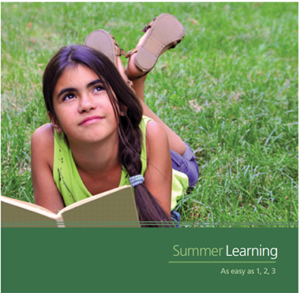Why do summer learning and wellness programs matter?
CSBA Summer Learning Series – Issue 1
This is the first in a series of articles focusing on strategies to promote student learning and wellness during the summer break from school. This installment presents an overview of the topic and the importance of effective summer programs in helping to close the achievement gap.
The ideal of the summertime idyll, of children spending warm days engaged in wholesome fun—cue images of tire swings over a lazy river—has always been mostly a myth. Two hundred years ago, summertime was school time. Most American children attended class primarily during the summer and winter, leaving spring and fall open to assist families and communities with planting and harvesting. Urbanization and universal education eventually expanded school calendars, and summer education largely disappeared by the late 1800s, replaced in part by the notion that summers should be “designated as a time for family vacations and a break from the mental taxation of school,” wrote Brenda McLaughlin and Jeffrey Smink of the National Summer Learning Association (NSLA) in a 2009 report for the Education Commission of the States.
That concept of summer still holds true for many American children. It’s a time designated for something other than traditional education. The question—and the problem—lies in how that “something” is defined. For middle and upper class Americans, “summer vacation” frequently entails family vacations, camps and local enrichment programs (sports/arts/music) provided privately or by community-based organizations. While these aren’t exactly the “mental taxation of school,” participating children largely continue to learn, in measurable and positive ways, through the hot middle months of the year.
For low-income families and children, however, it’s typically a different story. They often lack the resources to participate in activities that are comparable to those available to higher income families. For children in low-income communities, summer is more likely an educational drought, a period when not only are they not learning anything new, they are actually slipping backward and leaving behind knowledge they gained during the school year.
The Effects of Summer Learning Loss
When students return to traditional classrooms in the fall worse off than when they left in the spring, the phenomenon is called “summer learning loss.” Over the last several decades, the deleterious effects of summer learning loss have been repeatedly documented, from Barbara Heyns’ landmark 1978 study through the ongoing work of Karl Alexander and colleagues at Johns Hopkins University to the Rand Corp.’s 2011 study Making Summer Count.
Heyns, a New York University sociologist, spent two years following nearly 3,000 sixth- and seventh-grade students in Atlanta’s public schools. She found that children who read at least six books during the summer maintained or improved their reading skills, while children who did not read at all during the summer saw their literacy skills slip by as much as an entire grade level.
Alexander and research partners Doris Entwisle and Linda Olson were curious to learn more about this devastating effect and consequently launched a series of studies in 1982 which solidified and expanded evidence showing low-income youth suffer significant learning loss, both during the summer and long term.
In 2007, Alexander and his colleagues found that two-thirds of the ninth-grade achievement gap between disadvantaged students and their economically better-off peers could be explained by what happened over the summer during the elementary years. During the school year, children at all income levels tended to progress academically at about the same rate. But “over the summer, it’s a dramatically different story,” stated Alexander in an NSLA research brief. “During the summer months, disadvantaged children tread water at best or even fall behind [while] better-off children build their skills steadily…. The pattern was definite and dramatic. It was quite a revelation.”
Moreover, the academic degradation is cumulative. In the Rand study, the estimated average learning loss in math and reading for students not mentally engaged during the summer was one month per year. For low-income students, it was two months. Jennifer Peck, executive director of the Partnership for Children and Youth, says, “While middle-income children retain knowledge or, in many cases, make gains over the summer, low-income children fall behind. This learning loss is cumulative so when it occurs consistently over time, children fall so far behind that it becomes impossible to catch up.” In fact, by the time disadvantaged students enter high school, they are often years behind their peers, which subsequently plays a role in determining whether they will earn a high school diploma or pursue a college education.
Other Ill Effects
Children who do not participate in organized summer activities tend to suffer other adverse effects in addition to their ability to learn. In the 2010 Time magazine essay “The Case Against Summer Vacation,” writer David Von Drehle said summers spent like Tom Sawyer—glorious days of “mud, mild rebellion, chaste romance and rampant imagination electrified by a dash of gander and a blaze of heroism”—were largely fiction.
For many children, but especially children of low-income families, Von Drehle observed, “summer is a season of boredom, inactivity and isolation. Kids can’t go exploring if their neighborhoods aren’t safe. It’s hard to play without toys or playgrounds or open spaces. And Tom Sawyer wasn’t expected to care for his siblings while Aunt Polly worked for minimum wage.”
In such cases, summer is ironically bad for children’s health. A 2007 Ohio State University study measured the body mass index of several thousand kindergarteners and first-graders at different points over a two-year period. The study found that children gained weight two or three times faster during summer months compared to during school years. Children who were already overweight and who belonged to particular minority groups experienced the most significant weight change. The authors speculated that even the limited opportunities of structured, regular physical activity during the school year (e.g., organized sports, physical education classes, recess) were influential in moderating children’s weight. These activities also reduced children’s chances to excessively eat or snack.
“Children would weigh a lot more if it weren’t for the time that they spend in school,” said Paul von Hippel, statistician and principal investigator of the study.
“The data don’t provide much detail on kids’ home lives, but if you have some Tom Sawyer idea that kids are climbing trees all summer and only eat when called to dinner, that doesn’t square with the fact that they’re gaining weight so quickly. The other stereotype—that kids are watching TV, playing video games, and eating chips out of a bag—may be closer to the truth, at least for kids who are overweight.”
Eating poorly or not enough is a significant, well-known impediment to effective learning. Studies have shown diet can impair neural development in young children, resulting in lower IQs and decreased chance of success in school.
For many low-income students, summer breaks are also a break from healthy nutrition. Many children depend upon subsidized school meal programs to supplement substandard diets at home; when summer arrives, that aid frequently goes away. The Food Research and Action Center reported in 2010 that, nationally, only one in seven low-income students who relied upon the National School Lunch Program during the regular school year had access to summer meals.
The percentage of unserved children is comparable in California, but is particularly acute because of the large numbers of students involved. In a study last year by California Food Policy Advocates (School’s Out … Who Ate?), only 16 percent of the students who were receiving free or reduced-price lunches during the school year were also participating in a subsidized summer lunch program.
“And knowing that not all eligible kids are participating in the National School Lunch Program during the school year means the problem [during summer] could be even bigger,” said Patrice Chamberlain, director of the California Summer Meal Coalition. “We have nothing to suggest that the need somehow disappears or lessens during the summer. In fact, most community food banks report summer as the busiest time, suggesting that it is a time of real struggle for families.
“If kids living in low-income neighborhoods don’t have access to healthy food and safe places to play, what are we setting them up for? . . . It seems almost an unreasonable expectation for many of these lower-income students to be ready for school in the fall when they have gone part or all of the summer break without adequate nourishment for their bodies or minds.”
Summer Solution
The answer, according to a rising chorus of educators, academicians and others, is to expand and deepen summer enrichment opportunities for children, focusing first on those in low-income or disadvantaged families.
“Summer learning loss translates into achievement gaps and educational inequities,” said Jennifer Sloan McCombs, a Rand senior policy researcher and co-author of the Making Summer Count study, at a recent national conference of school administrators. “Students, especially low-performing students, need more learning time—and summer is a time to do that.”
But how? Years of an uncertain economy, combined with declining government monies and subsequent budget cuts, have left most school districts in California and around the nation struggling simply to get through a painful period of consolidation and contraction. Summer programs tend to be among the first things cut. A recent California School Boards Association survey of 167 districts found that 32 percent had closed their programs within the past five years. The reason for the closures was almost universal: No money. With their basic educational mission confronted by ongoing funding threats, that have forced them to trim the traditional school year to save money, few school administrators and governing boards feel they can justifiably boost summer spending.
Instead, they often go the opposite way. There is no more dramatic example of that trend, according to the California education research organization EdSource, than in the Los Angeles Unified School District, the state’s largest with 667,000 students. In 2008, the district spent $51.4 million providing summer academic classes. In 2011, it spent $3 million and limited enrollment to one class per student. Not surprisingly, that translated into far fewer participating students: from 188,500 students in elementary through high school in 2008 to just 22,000 high school students in the summer of 2011. Last year the district reluctantly offered its smallest summer program ever, a $1 million bare-bones operation serving only 5,000 high school students.
It’s not all grim news, though. A number of districts around the country, including in California, have not only maintained summer programs, they have improved them both in scope and quality. The CSBA survey found that 68 percent of districts surveyed offered summer programs or summer school by pulling together general fund, Title I, after-school supplemental and private funding despite hard times.
In California, the Summer Matters campaign brings together a coalition of education leaders, policy advocates, funders, researchers and program providers to strategize about making high-quality summer learning part of a year-round set of opportunities for all students. This work has seeded a growing number of school-based programs around the state and continues to grow.
The Summer Matters campaign has generated 13 model summer learning programs across the state, with documented impact on children’s learning. Other districts and local organizations are taking note and beginning to pull together resources to make summer learning happen in their communities.
Their approaches are varied and creative, and are often tied to the particular attributes and resources of their communities. Their stories may offer lessons for everyone else.




